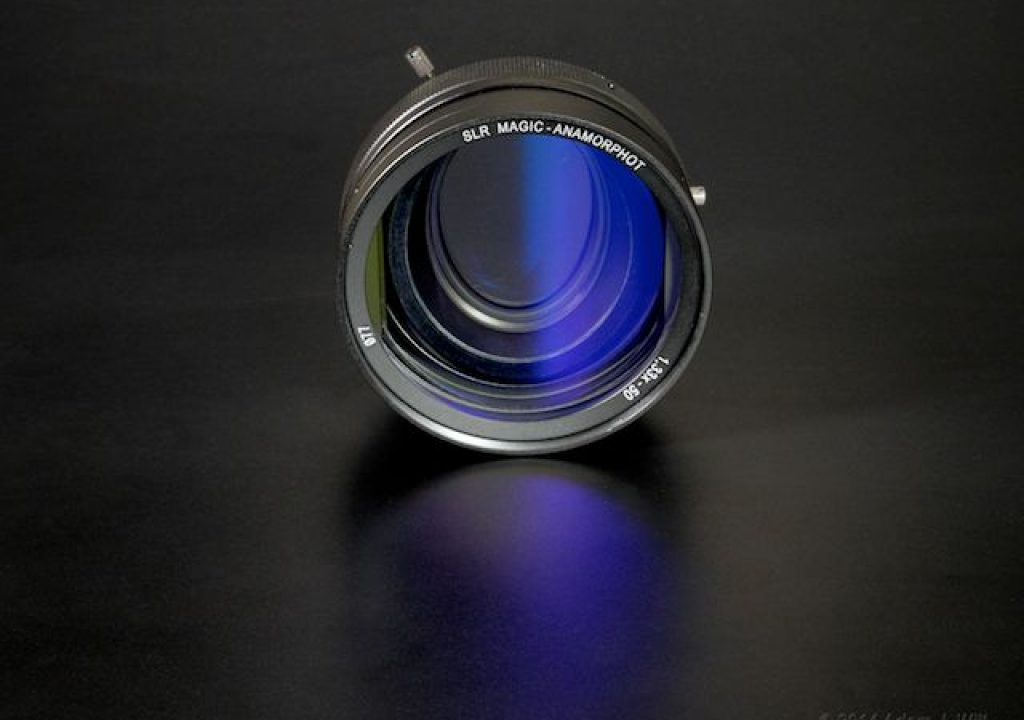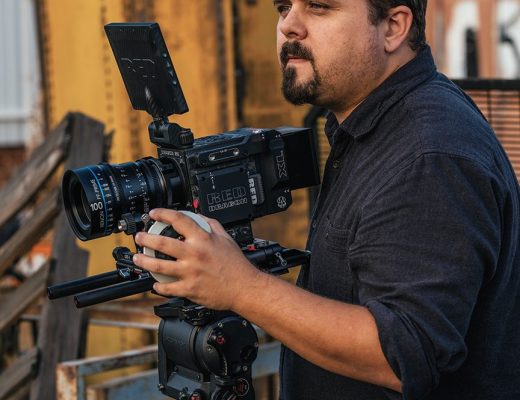SLR Magic's ANAMORPHOT 1,33x 50 is an affordable anamorphic adapter lens (US$899; $1099 with two diopters) letting you shoot 2:37:1 widescreen on a 16×9 camera, or, if you're in a retro mood, 16×9 widescreen on a 4×3 standard-def camera. It works on lenses with a clear front aperture of 50mm or less and a filter thread of 62mm or less.
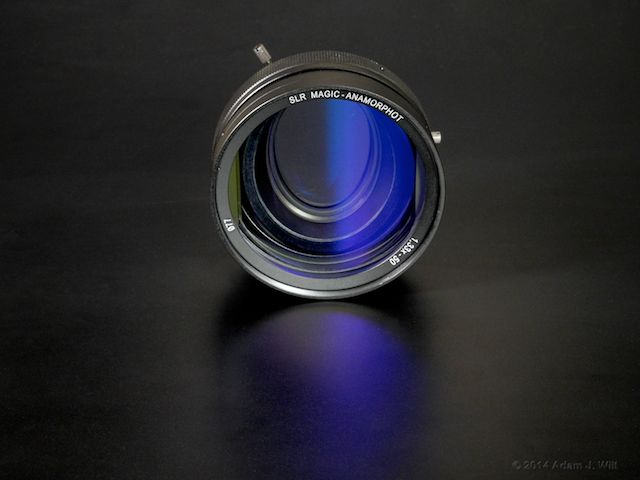
SLR Magic ANAMORPHOT 1,33x 50
The adapter lets you capture a CinemaScope-like widescreen image with many (if not all) of the characteristics of a classic 2:1 anamorphic lens.
I've already written about a prototype of this adapter and discussed many background issues with anamorphic lenses in that article. For the most part, I won't repeat that info here; I'll cover what's different with the shipping version of the lens and look at how it performs.
The ANAMORPHOT differs from the prototype in two important ways. First, it has improved coatings (see image above) that provide the classic “blue anamorphic flare”. Second, it's shipping and available, making it one of only two currently-produced anamorphic adapters, the other being the Letus AnamorphX, a considerably larger, heavier, and pricier option.
Design and Construction
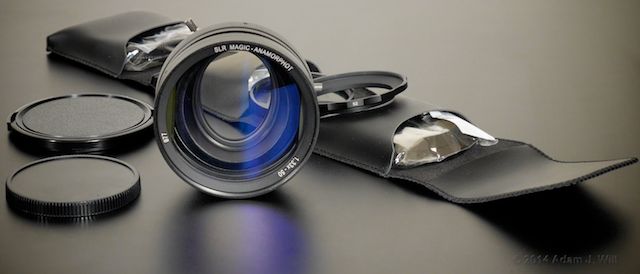
The adapter and its accessories
The adapter arrives with a 77mm front cap, a 62mm rear cap, and a folding wallet with step-up rings to fit the lens on 49mm, 52mm, and 58mm lenses.The stepping rings have scalloped edges for good grip when screwing them down, and each one includes it own rear cap, so you can protect the lens even with a stepping ring attached – a nice touch.
The adapter weighs 13.4 ounces / 380g; it's pretty much solid metal and glass. The barrel has a matte black finish that seems reasonably scratch-resistant (not that I tried to abuse it), and has three black-chromed setscrews evenly spaced around the back of the mount. These setscrews are loosened to rotate the lens to its proper position (cylindrical element oriented vertically) once the adapter is firmly screwed into the main lens (“main lens” is how I'll refer to the prime or zoom you attach the adapter to), and then tightened back down to lock it in place.
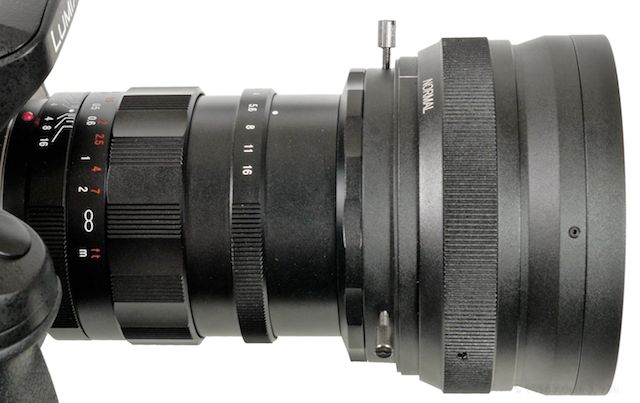
Adapter on a Nokton 25mm. Note the protruding setscrews.
The setscrews have a gently knurled surface allowing them to be finger-tightened.
Product manager and lens designer Andrew Chan suggests aligning the adapter byshining a bright flashlight into the lens and then rotating it until the anamorphic flares are perfectly horizontal. This works a treat; in practice I could align the adapter in only a few seconds, using the horizontal guidelines in my GH4's display as targets.
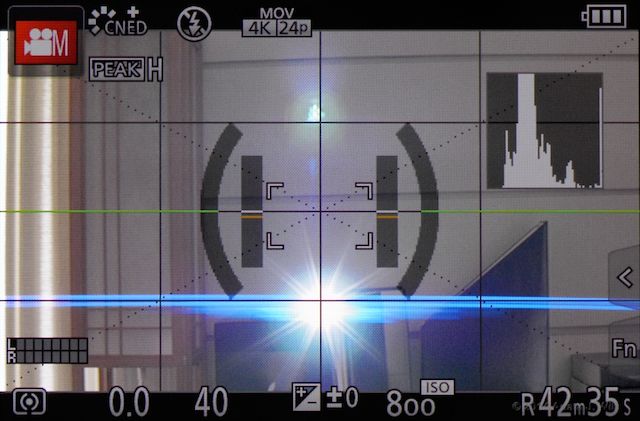
Aligning the adapter using an LED flashlight and the adapter's rich blue flare
The lens also has a focusing ring to allow the cylindical element to be properly adjusted for the subject distance. Older anamorphic adapters like the Panasonic AG-LA7200G or the Century Optics widescreen adapter were properly corrected for infinity focus, but required you to stop down more as you focused closer. The adjustable focus on the ANAMORPHOT (as on many traditional Hollywood anamorphics) lets you converge both horizontal and vertical focus at your subject's distance.
In practice, I'll focus “vertically” (such that horizontal details in the image are crisp) with the main lens wide open, then adjust “horizontal” focus (bringing vertically-oriented details into focus) using the adapter's ring.
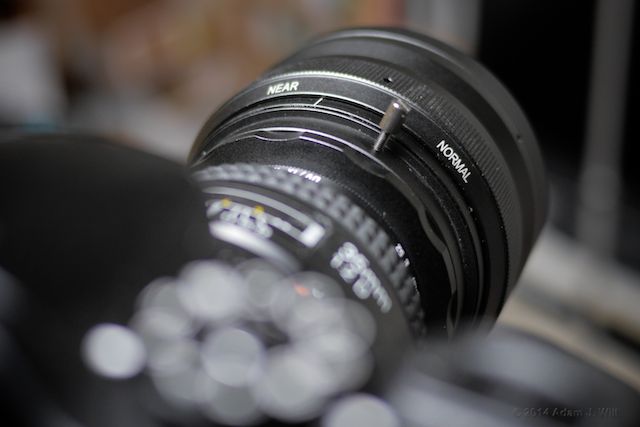
Adapter on a 35mm f/2 Nikkor; subject is 5 feet away
The focusing ring is only labeled NEAR and NORMAL because the actual correction needed depend on the optical interaction betwwen the adapter and the lens you mount it on. NORMAL is (presumably) always the appropriate setting for distant subjects, but the NEAR point varies with your main lens: with the AF-Nikkor 35mm f/2 D on my GH2, the NEAR point is about 3.5 feet, while on the 25mm Nokton f/0.95 the NEAR point is 5 feet.
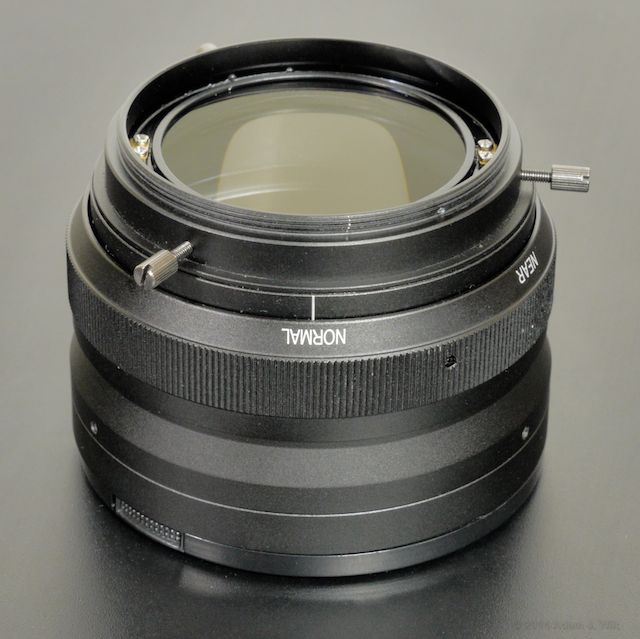
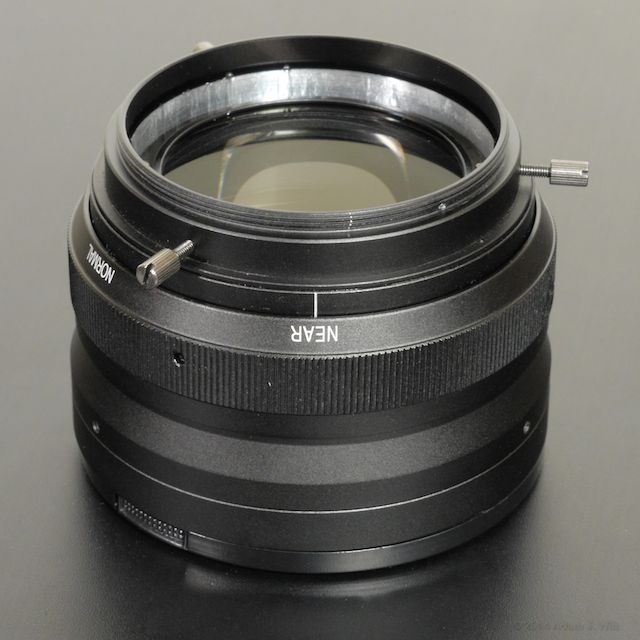
NORMAL and NEAR focus travel. Does that bit of shiny metal revealed at NEAR focus increase flare? I didn't notice any, but would that be a bad thing?
In theory, this additional focus ring lets you keep your subjects in focus wherever they are between the NEAR and NORMAL limits, even at wide apertures. Practically speaking, it works very well for a fixed subject distance, but if you need to pull focus during a shot and can't afford to stop down (which increases the “depth of field” in which both H & V focus is preserved), you'll need to ride focus on both your main lens and the anamorphic adapter at the same time:
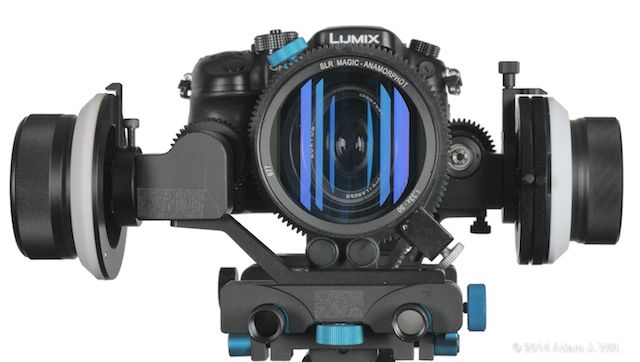
Possible? Yes. Practical? Maybe not so much…
If you go this route, you will want at least one camera assistant to help with the pull, preferably two!
Pulling focus on the ANAMORPHOT affects the bokeh – the appearance of out-of-focus elements – with the oval anamorphic look of distant points of light becoming rounder as focus is shifted NEARer. SLR Magic offers a matched set of 77mm diopters (close-up lenses) so that you can leave the adapter's ring at NORMAL and still keep closer subjects focused both horizontally and vertically.
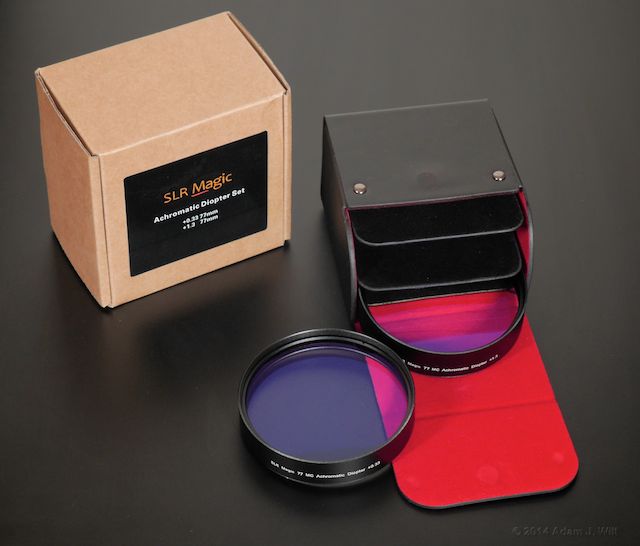
Diopter set for the ANAMORPHOT
These diopters have the same intense blue lens coatings as the ANAMORPHOT itself and a slightly glossier black metal finish. They screw into the adapter's front thread and are threaded themselves, so you can even (gasp!) stack them. Once fitted, they are a natural extension of the lens itself.
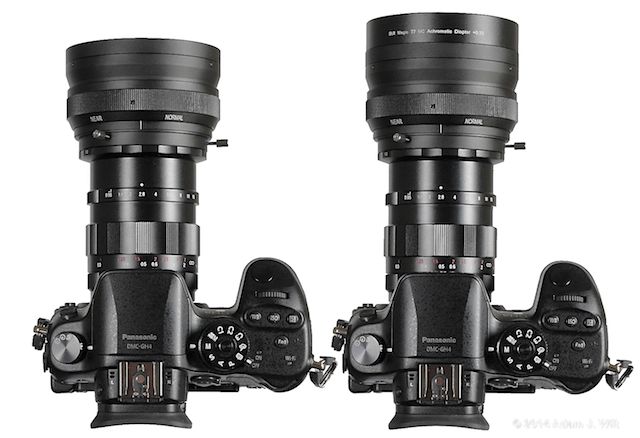
The diopters change the working range of the lens at full wide aperture, but do not eliminate the need for the NEAR-NORMAL focus ring: they simply bring the working range closer. For example, on my 25mm, with a normal range of 5 feet to infinity, the 0.33x lets me work wide-open from 2.5 to 10 feet, while the 1.3x lets the lens focus H & V from 22 inches to 3 feet. Your main lens may yield a different result, and in all cases stopping down will extend the usable ranges considerably.
Next: Performance and Conclusions
Performance
Evaluating performance on an anamorphic is a fraught activity: anamorphics as a class have never been noted for pinpoint sharpness and perfectly accurate rendering; indeed, their very flaws (as seen from a technical perspective) are what endear them to many. I'll look at how the lens performs, and point out various aspects of that performance, but bear in mind the difference between a clinical perspective and a critical perspective: I'll point out things that are, clinically speaking, deviations from optical perfection, but many of them are part and parcel of using an anamorphic adapter.
Also bear in mind that what you see depends on the main lens you use behind the adapter: the two lenses need to work well together. I used a Nikkor 35mm and a Nokton 25mm and my observations are valid with those two lenses only. If you use a different lens, your results may be better or worse; my results should be taken as descriptive rather than prescriptive.
The “classic anamorphic look” consists of a wider-than-normal perspective, distorted bokeh (most obviously seen in ellipsiodal out-of-focus lights), and horizontal flare – normally blue – sufficient to warm the cockles of J. J. Abrams' heart. Beyond “the look”, there's the issue of overall sharpness and aberrations, things that challenge most anamorphic adapters.
Wider-than-normal perspective: the ANAMORPHOT gives you that, all right:
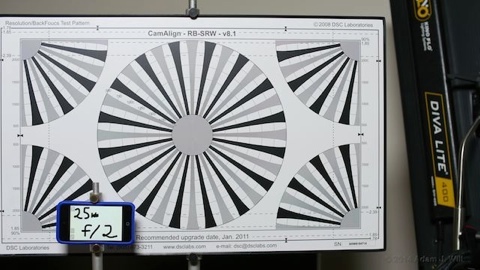
View through the 25mm, no adapter
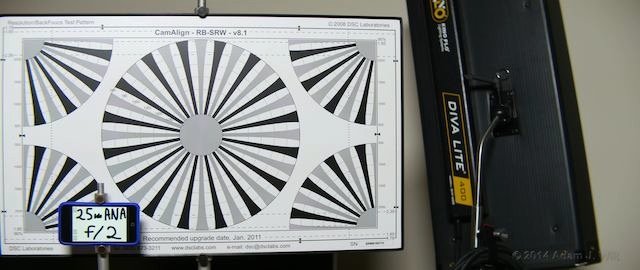
View through the 25mm, with the adapter
Of course, you'll have to stretch your image in post, as I've done here; the view through the adapter is just like that of a 16×9 show displayed full-frame on a 4×3 screen: 33% lateral squish. (You'll observe that I kept the chart framed at the edge of the image, not the center; what happens at the edges of an anamorphic image are just as important as what happens at the center. More on this later.)
The lens is billed as a 1.33x adapter; I found the amount of horizontal squish varied slightly depending on subject distance and NEAR/NORMAL setting. With the subject at infinity (well, at 100 feet or so), I needed the stretch the image horizontally by 135% to match it up to a “flat” or “spherical” image taken without the adapter; at three feet the image only needed 128% stretch at the NEAR setting, and 131.5% at NORMAL. Overall, it averages out to 133% for subjects in a middle distance (say, around 10 feet or so, depending on your main lens); these minor aspect-ratio differences aren't something to be alarmed about, but aware of.
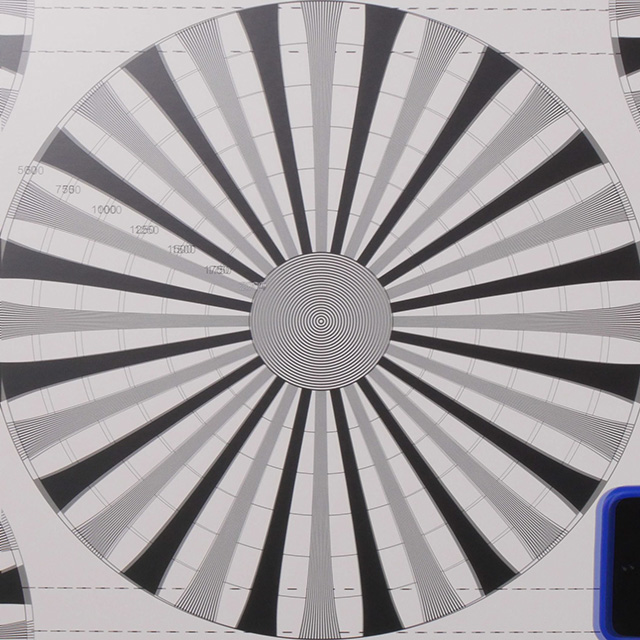
50% superimposition, square crop of chart at both NEAR and NORMAL settings, shot from 5 feet away
When close-up images are de-anamorphosed in post with a 1.33x stretch, they are slightly wider than one would expect. In the image above, the narrower of the two charts is at NORMAL focus, while the wider one is at NEAR focus – and both are wider than they “should” be; they “should” fit within the horizontal confines of the square crop just as they do vertically.
“Anamorphic mumps” is a historical disease ascribed to subjects being (a) too close to and/or (b) too centered in the image of anamorphic lenses; I'm guessing this is the modern presentation of that dread disease. In days gone by it was apparently pretty horrific, but in those days a 2:1 squeeze was used – 3x as much as on this adapter – and so the mumps then were probably three times worse than they are now.
If this is something that concerns you – nobody wants the leading lady to be afflicted with mumps, least of all the leading lady herself – remember that you aren't required to desqueeze your images by 133%. It's all software: you can use a milder desqueeze of 128% or 131% or whatever works for your lenses at your working distances as you see fit, with mild image resizing as needed to fill the screen horizontally and vertically.
(How did I get both NEAR and NORMAL to focus properly 5 feet away, you ask? Simple: I stopped down to f/11.)
Furthermore, the adapter imparts a slight barrel distortion to the scene:
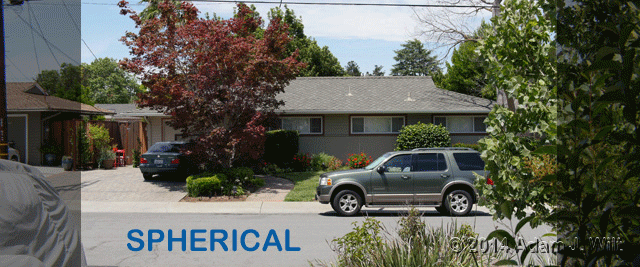
Comparison of anamorphic and spherical images of the same scene. 25mm with and without the ANAMORPHOT
That slight distortion also results in edges getting slightly more squish than the center, so central elements seem a bit fatter… more “mumps”?
None of this is especially worrisome; it's just something to be aware of if, for example, you're trying to match flat and anamorphic footage, or generate VFX that need to line up with live action… or keep your heroine from gaining weight as she walks towards camera. All anamorphic adapters I've seen show similar distortions, often to greater degrees: the ANAMORPHOT does very well by comparison.
Distorted bokeh: the ANAMORPHOT does its best, but no 1.33x adapter can give you the highly elliptical bokeh of a classic 2:1 anamorphic with three times the lateral squish. Furthermore, the appearance of bokeh is highly dependent on the main lens you have the adapter attached to.
I tested for bokeh with a fairly limited setup:
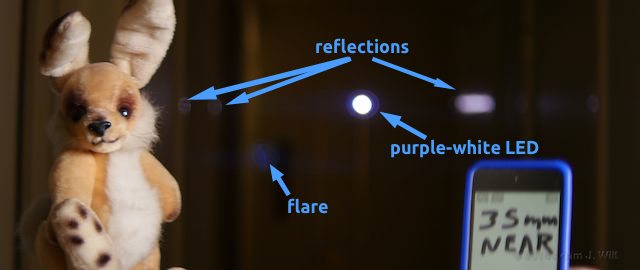
Test rig: LED light at end of hall, Barney modeling in foreground
In these tests, I used a 35mm Nikkor f/2 lens wide open, and a 25mm Nokton lens also at f/2. A white LED with a purplish cast is 25 feet down the hall. You'll see three purplish reflections (oops, sorry Art: three minus-greenish reflections, grin) on the doors and doorframes in the hallway; ignore these. Flare from the ANAMORPHOT is always blue, and any greenish flare is bounce off the GH4's sensor. Note that this wasn't a flare test (the LED wasn't that bright) but some interesting things happened anyway, if you care to look closely.
Most of the time Barney is three feet six inches from the camera with the 35mm lens and five feet from the camera with the 25mm lens, but when I switched to the 1.3x diopter, infinity focus on both main lenses resolved to 3 feet, so I moved in to 3 feet for those images.
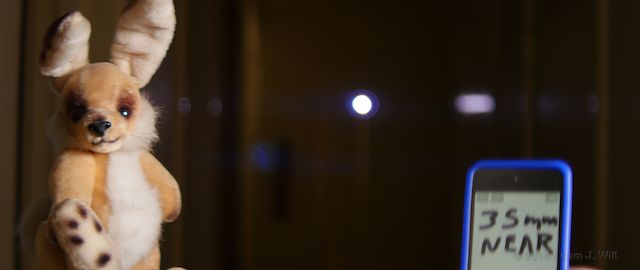
NEAR focus, with round bokeh
Here's the problem with focusing the anamorphic: when I get my subject nicely balanced between H & V focuses, my out-of-focus LED renders as a round blob, not the anamorphic ellipsoid we'd like to see.
There's a slight blue halo around the LED, and a very mild flare radially opposite it.
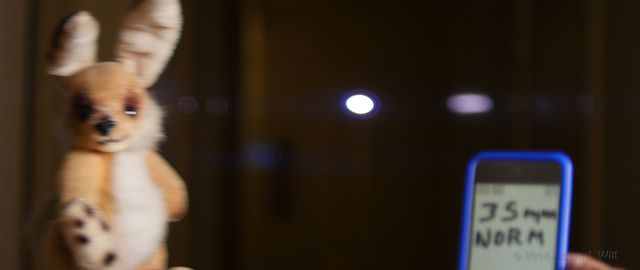
NORMAL focus, elliptical bokeh, but blurry subject
Setting the adapter to NORMAL gives me nice bokeh, but alas, my subject smears horizontally.
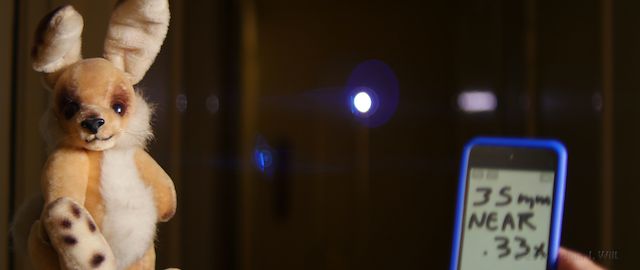
0.33x diopter; still needed NEAR focus setting
With the milder diopter, I still needed the adapter at NEAR for proper subject rendering. The bokeh is, if anything, slightly elongated vertically, which is not displeasing… but look at the flare: there's a second, big elliptical blob hovering around the LED, and much more prominent “sunstar” flare opposite the LED.
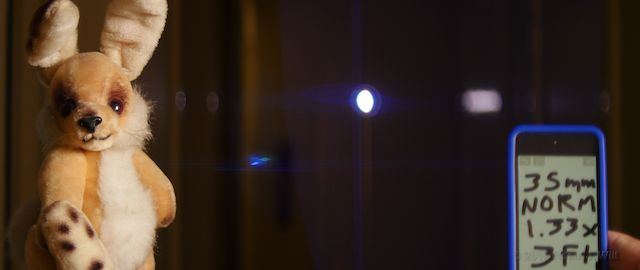
1.3x diopter; NORMAL focus setting
With the strong diopter I had to move in closer to get anything in focus (the main lens was at infinity; strong diopters do that!). The LED's bokeh hasn't gone all egg-shaped, but look at the flare! There's both horizontal and vertical streaking, a different sunstar (with green sensor bounce at no added cost), and that second ellipsoidal blob? It's hard to see in this image, but it's covering the entire right-hand side of the picture.
That's all with the AF-Nikkor 35mm f/2 D lens. Now, let's try the 25mm Nokton f/0.95 at f2:
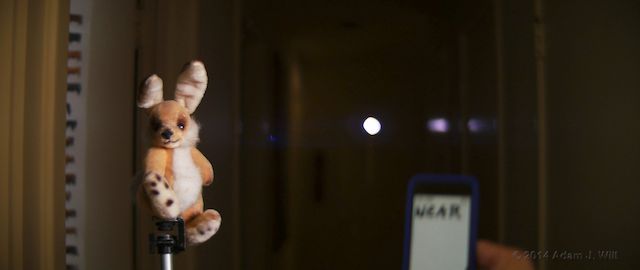
25mm main lens, NEAR focus setting
The predominant shape of the bokeh is a “cat's eye” distortion from the off-axis placement of the source, which became more lens-shaped the farther off-axis I moved it. Yes, with the adapter in NORMAL it was slightly more elliptical, but not as much as on the 35mm. No halo flare, and not much of a radially opposed sunstar.
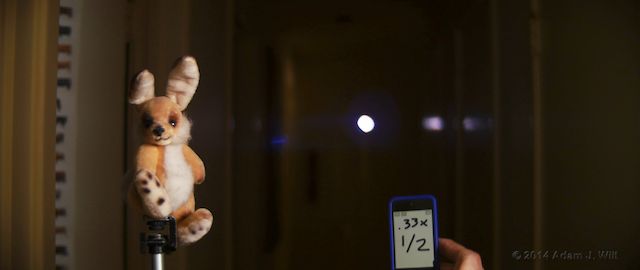
0.33x diopter, focus halfway between NEAR and NORMAL
With the milder diopter, no real change… and no radical increase in flare, either.
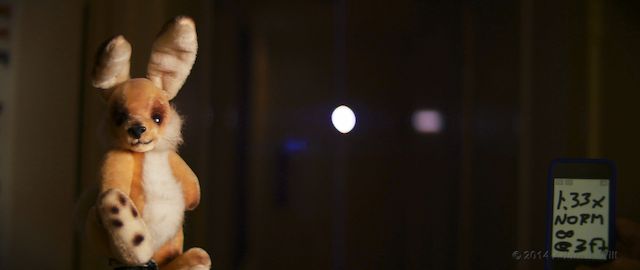
1.3x diopter, NORMAL focus (I had to move in to 3 ft from subject to be able to focus)
With the stronger diopter, there's a hint of that vertical flare, but again, nothing so prominent as with the ANAMORPHOT and the diopter on the 35mm lens.
With both main lenses, I never got a really satisfying, CinemaScope-like elliptical bokeh, not once I got proper horizontal and vertical focus set on my subject whether by focus ring alone or with the aid of the diopters. Some of this may be due to my choice of main lenses; other lenses will perform differently (and an LED at 25 feet isn't quite the same as a streetlight at 200 feet, too, though I took the gear out at night with no noticeably different results).
But part of it is that a 33% squeeze lens will never give you the same look at a 100% squeeze lens. If you need that look, you'll have to shell out for a real film-style 2:1 anamorphic and an Alexa Studio to put behind it…. or, make your own front-of-the-lens bokeh apertures.
Blue flare: the production ANAMORPHOT gives very satisfying horizontal blue streaks on bright sources as the screenshot on page 1 shows, and various other blue flares depending on the lens you attach the adapter to.
Hallways tests are all fine and well, but real-world footage is better, both for focus / bokeh issues and for flare characterization. There are quite a few such clips listed in my “Entering Production” writeup, and a recent useful demo – useful in that the footage shows attractive flare and occasional elliptical bokeh with the Sigma 30mm 1.4 that Mr. Contreras used, but that neither flare nor bokeh are ubiquitous by any means.
Without a side-by-side test it's hard to be sure, but I'd say the Sigma 30mm does a better job of showing elliptical bokeh than the 35mm Nikkor I used, and allows a much better squishy bokeh than the 25mm Nokton.
Sharpness and Aberrations: the ANAMORPHOT's optical performance is dependent on its playing well with whatever main lens you mate it to. As I found before, it seems to marry up nicely with the 35mm Nikkor and the 25mm Nokton, but the AF-Nikkor 50mm f/1.4 D, by itself a crisp and snappy lens even wide open, failed to play nicely with the ANAMORPHOT until stopped down to at least f/5.6 or f/8. So take my findings as indicative of how the adapter might work with your lenses, not as definitive statements of how it will work.
Even with well-matched main lenses, anamorphics have a tendency to soften the image at wide apertures: it's not a question of if, it's a question of how much. Indeed, SLR Magic recommends stopping down a bit:
Recommended maximum aperture values:
f/2.8 should be used for 20-50mm focal length.
f/4.0 should be used for 55-85mm focal length.
f/5.6 should be used for 90-135mm (Trial and error) focal length.
I shot a test chart with and without the anamorphic, as shown in the two images at the top of the page, at f/2, f/4, and f/8 with both the 25mm and 35mm lenses, and also at f/0.95 with the 25mm.
Both of these main lenses are somewhat soft wide open, with low contrast and fuzzy details (the Nokton, like many other “hyperprimes” or “superspeed” lenses, also has amusing radial chromatic aberrations, entertaining coma, and substantial veiling flare when it's wide-freakin'-open). Neither one really crispens up until closed down a stop or two.
Pixel-peeping the charts with both lenses, the adapter softened the image “about two stops”: the lens with adapter was roughly as sharp at F/4 as the lens alone at f/2. However, the Nokton/ANAMORPHOT combo seemed better matched in terms of contrast; it looked crisper at wider stops than the Nikkor/ANAMORPHOT combo, when compared with the main lenses alone. Put another way, my subjective impression looking at pictures (not counting lines or looking at blur radiii) was that the adapter was within a stop of the naked 25mm in terms of apparent sharpness, while the adapter on the 35mm trailed the unadorned 35mm by about two stops.
A stop or two less sharp may not sound too hot, but it's very impressive for an anamorphic adapter. Put another way: I'd happily use it on either of these lenses at f/2.8, and I wouldn't worry about using it at f/0.95 on the Nokton in any situation where I'd find the naked Nokton at f/0.95 acceptable. Anamorphics may be image softeners, but the ANAMORPHOT holds sharpness better than the other adapters I've tried.
Adding a diopter reduced sharpness at large apertures noticeably (if not necessarily objectionably). This is to be expected: diopters are also notorious image softeners. As with the adapter itself, the SLR Magic diopters do very well for what they are.
In terms of aberrations, both lens combos showed some lateral yellow/blue chromatic aberration in the horizontal direction: perfectly clean in the center of the image with color fringing increasing towards the sides. On my aspect-ratio-corrected, 5120×2160 images, these color fringes were perhaps four pixels wide at the extreme left and right sides of the 35mm image. On the 25mm, those same fringes were about 12 pixels wide. In both cases, the color fringing did not vary with aperture. (Does my experience predict the amount of color fringing you'll see on your lens? No it does not, not unless you're using the same lenses I am.)
As discussed above, the appearance of radial “sunstar” flares as well as halation around light sources varied depending on the main lens used. The trademark horizontal flares, the ones that shout “anamorphic”, are happily present in great profusion regardless of the main lens used, as long as you have a sufficiently bright source. I found I could even do the J. J. Abrams trick of standing just out of frame with a bright LED flashlight aimed into the lens, generating copious quantities of glowing blue lines.
Operational Issues
The lens is more than 3/4 of a pound or a third of a kilogram, so it needs a solid lens behind it. The fully manual Nokton and SLR Magic's comparable Noktor Hyperprimes, all with substantial helical focusing grooves, are naturals. The 35mm and 50mm Nikkors with their lightweight screw-driven focusing mechanisms were a bit of stretch. Lenses with linear focusing motors or lightweight zoom mechanisms might be overstressed supporting this heavy adapter; I handheld it in front of my Lumix 12-35mm f/2, but didn't feel comfortable hanging it off of that lens.
To work with the adapter, a lens should have a front element no larger than 50mm in diameter and should not so wide-angle that it “sees” the edges of the adapter. The 12-35mm Lumix didn't get a clear view until it zoomed in to 14mm or longer. There is no detailed compatibility guide that I know of, but SLR Magic suggest these focal length and sensor size combinations:
• 17-85mm for Super16 sensors.
• 20-85mm for Micro 4/3 sensors.
• 35-85mm for S35 and APS-C sensors.
• 40-85mm for Full Frame sensors.
The three setscrews used to lock the adapter rotationally concern me; they stick out quite a bit and seem prone to being bent or broken off accidentally. I haven't tested their robustness, but I worry about it.
The NEAR/NORMAL focusing mechanism on my review lens was a bit stiff and sticky, though it would loosen up if I gave it a twist back and forth just before using it. Andrew Chan warned me that this one was on the stiff side, and says that normally they're smoother in operation.
There are a few flecks of dust in the lens. SLR Magic says these are to be expected and do not affect image quality.
Conclusions
The SLR Magic's ANAMORPHOT 1,33x 50 is a solid, worthwhile widescreen adapter. Its NEAR/NORMAL focus adjustment makes it usable at closer working distances and wider apertures than older, fixed-focus units like the AG-LA7200G or the Century Optics 16×9 adapter. It opens up your frame to a whopping 2.37:1 and flares very pleasingly.
Build quality, while not Leica-luxurious, seems quite substantial, and aside from the protruding setscrews the adapter looks and feels like it'll take a few hard knocks and keep on going.
Those expecting the squishy elliptical bokeh of classic 'scope lenses will be underwhelmed, but that's not the ANAMORPHOT's fault: a 1.33:1 squeeze simply can't generate the same skinny ovals as a 2:1 squeeze. That aside, the subtly different horizontal and vertical focusing characteristics give out-of-focus objects that trademark anamorphic feel.
The ANAMORPHOT suffers from the maladies that afflict all anamorphic adapters to some degree – distortions, horizontal chromatic aberrations, subtle squeeze variations depending on a subject's lateral positioning and focal distance, image softening – but it bears these burdens lightly. They don't detract from performance so much as give the adapter's images a particular character. When mated with a compatible lens, the ANAMORPHOT gives you the widescreen, flarey pleasures of anamorphic work with comparatively few downsides.
The matched set of diopters allows work at closer distances, and offers an additional set of characteristic flares and streaks. The diopters cost $200 if bought as a set with the adapter, or $300 if bought separately; if you find them intriguing, I'd recommend buying them as part of the set.
The biggest issue? The ANAMORPHOT's behavior is very dependent on the lens it's attached to, so unless you're able to find test footage using the same lens(es) you plan to use, there's no way to predict how well the adapter will work with those lenses and what sorts of bokeh and flares you can expect. However, if you keep your eyes on the various discussion lists and Vimeo and YouTube channels, you're likely to see many of the most appropriate lenses used and discussed, so you needn't jump in completely blind.
Pros
- Excellent image quality for an anamorphic adapter.
- Affordable.
- Compact and lightweight, as such things go.
- Focus adjustment allows use at near distances, wide apertures.
- Delightful blue flare.
- Widescreen images make 16×9 HD look as primitive as 4×3 SD!
- Includes three step-up rings.
Cons
- Rotation setscrews stick out quite far, and are liable to get bent or broken if mishandled.
- A 1.33x anamorphic can't give you the skinny elliptical bokeh of a 2x anamorphic.
Cautions
- Performance is very dependent on the main lens you mount the adapter to.
- Adapter is heavy enough that servo-driven lenses with lightweight focusing / zooming mechanisms may bind up from the added weight.
- The adapter generates a squished image: you must desqueeze it in post, and deal with a squeezed viewfinder image.
- Focus-pulling, if needed on both the main lens and the adapter, is a complex operation.
More Info
SLR Magic doesn't have the ANAMORHOT on SLRMagic.com, but it's on their UK website, complete with a user's manual.
See my preview article for background information and Entering Production for a variety of sample videos. YouTube and Vimeo offer plenty of images, too.
In the USA, the adapter is available from all the usual suspects, plus a few vendors I hadn't heard of before… your search engine is your friend!
Disclosure: SLR Magic loaned me an adapter and diopter set for review, but did not offer me compensation or special consideration for this writeup. I own the GH4, Nokton, and other Panasonic and Nikon lenses tested; all bought for previous projects at regular market prices.

Filmtools
Filmmakers go-to destination for pre-production, production & post production equipment!
Shop Now